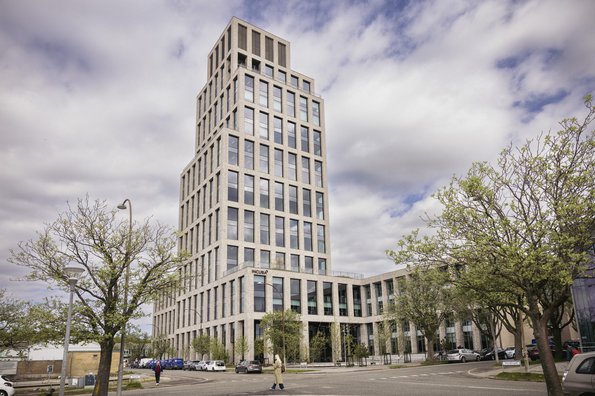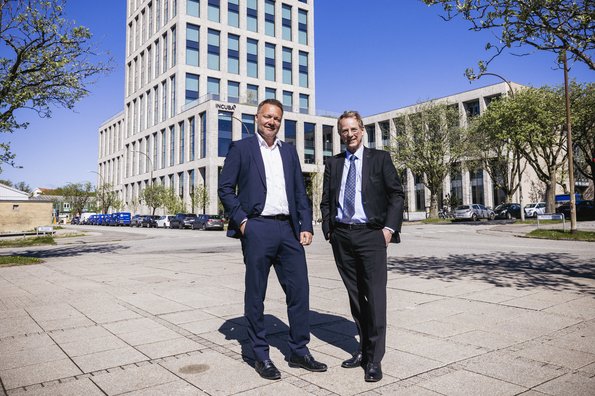INCUBA Next A lighthouse for transforming IT research into viable businesses
INCUBA’s expansion of the Katrinebjerg science park has future-proofed its position as a Mecca for information technology. Now successful growth companies that have outgrown the setup can stay on and continue to be part of the environment.
By Filip Graugaard Esmarch
The Aarhus skyline is changing. When the INCUBA Next building welcomed its first tenants in October 2024, this beautiful beacon in Katrinebjerg was one of the five tallest buildings in the country. Some say that the new growth lighthouse has the best view of the city. Standing on higher ground, the 18th floor of the INCUBA tower is level with the 45th floor of the tallest building in the country, the Lighthouse on Aarhus Island.
‘It is great. From here, I can see all the different places I have lived’, says Peter Frandsen from his office on the 12th floor. He describes the building as a piece of beautiful architecture with well-arranged facilities and good acoustics despite the large floor-to-ceiling height.
Peter Frandsen is a partner at Partisia – a company developing and implementing state-of-the-art data encryption solutions. Like a lot of other INCUBA companies, Partisia emerged from research conducted at Aarhus University. In fact, the University’s Department of Computer Science is said to rank among the global top three in the field of cryptology. It is located on the other side of Åbogade next to the Alexandra Institute.
In 2018, Partisia moved from the Alexandra Institute to INCUBA, and in August 2022, it was the first to sign a lease on an entire floor in INCUBA Next. Construction of the building began in April that year. At the time, the company had a staff of 35, but when it moved into INCUBA Next in 2024 the number had doubled, and Partisia therefore decided to lease a second floor to allow for continued growth, hoping to reach a couple of hundred employees sometime in the future.
‘We have reached a stage where we are ready to grow based on external capital, and we have therefore leased the 12th and 13th floors. Before moving to INCUBA Next, we moved around a lot, as our needs changed, and this degree of flexibility has been a great advantage to us. But up here, we are able to build something entirely different. Having our own place has boosted the social aspect of the company and our sense of building something from the ground up’, says Peter Frandsen.
Retention of scale-ups
The original INCUBA Katrinebjerg was built in the 2000s and consisted of six four-floor wings with offices ranging from 10 to 150 square metres and a total of 750 office spaces. Today, a tower has been added to the original building along with a new six-floor annex, providing 1,200 new office spaces and larger offices of up to 500 square metres as well as communal facilities shared by all INCUBA tenants.
‘INCUBA used to be a place for start-ups, which would move out when they had grown too big. But a lot of these companies actually want to stay on and continue to be part of the environment at the science park and the University’, says Director Jørgen Lang from AUFF, the majority shareholder in INCUBA.
‘This expansion helps us to strengthen the interaction with Aarhus University, as even more research is utilised and disseminated to companies that grow and develop amazing solutions of benefit to society’, he concludes.
Jørgen Lang is extremely happy with the result. However, he makes no secret of the fact that the decision to build the 22,000-square meter extension was something of a gamble, especially considering that INCUBA did not have any tenants for the new facilities at the time. According to INCUBA CEO Jacob Doktor Mogensen, the process of attracting new tenants is going as planned, though.
Kurt Nielsen (CEO) and Peter Frandsen (CCO) make up the senior management at the innovative cyber security company Partisia. One of INCUBA Next’s large roof terraces is right outside their offices. All INCUBA tenants have access to the large terraces, some of which are best described as roof gardens.
‘At the beginning of the year, we had let around 50 per cent of the new facilities. Here it is important to point out that the new tenants are exactly the type of companies that we had hoped to attract. It shows that there is a need for the facilities and that we were right to launch the project. Now we just need to be patient and wait for the right tenants for the remaining facilities’, says Jacob Doktor Mogensen, who has turned down companies that did not have the right innovation or growth perspective.
A mix of large and small companies
The close proximity to the University is vital to Partisia.
‘We employ a lot of student programmers. In fact, a third of our staff is students. In addition, we hold meetings with leading researchers at Aarhus University every week. So it is important for us to be within walking distance of the Department of Computer Science’, says Peter Frandsen.
The entrepreneur mentality at INCUBA is another advantage.
‘It is important for me to be part of a start-up environment, as Partisia buys services from some of the smaller companies. It is great to be part of an environment where you help each other grow’, Peter Frandsen says and adds that being a part of INCUBA is a great opportunity to make new contacts.
INCUBA hosts regular events for its tenants and the local start-up eco system, including networking breakfast, Gin & Tech, wine tasting, INCUBA Exclusive, Aarhus Investor Summit and the DHL Relay Race – events that give the participants access to new cooperation partners, capital and knowledge.
The missing piece
Peter Frandsen describes the relationship between Partisia and INCUBA as symbiotic – and CEO Jacob Doktor Mogensen agrees:
‘Our aim is to turn INCUBA into a North European lighthouse based on Katrinebjerg’s unique knowhow and existing positions of strength and to thus help transform more research into more businesses. We have decided to focus on companies in the cyber security sector’, he says.
Aside from Partisia, INCUBA Next houses strong companies such as Kvantify, CrowdStrike, Scalgo and Better Collective. For more information, go to incuba.dk/hubs/flyt-ind, or download the new book “INCUBA Forskerpark i Aarhus i 40 år” at incuba.dk/incuba.
‘We now have the best possible setup for companies facing rapid growth. INCUBA Next is the piece that has been missing in the selection of entrepreneurial services offered on campus. We now have The Kitchen, where companies are born, and the next step is Level2, which will be housed in the partner building that FEAS is building in the University City. At INCUBA, we have StartupLab, Mentor Team and community – as well as the physical facilities to support the scale-up journey from research to commercial activities’.
Jacob Doktor Mogensen stresses that INCUBA Next is not a community as such, but can best be described as an integrated part of the science park. He considers INCUBA Next a project title and prefers to talk about the new facilities as part of a united INCUBA Katrinebjerg.
Make a real difference
The creation and expansion of the IT City has been laid out in several district plans since FEAS in 2014 released a master plan for the area, which was to become a part of campus, and the City of Aarhus designated Katrinebjerg a conurbation area back in 2017.
‘I would like to commend the City Council for being visionary and for insisting on creating something that would really make a difference and advance the development of Aarhus and the region as a whole’, says Director of FEAS and AUFF Jørgen Lang.
The district plan for the development of Katrinebjerg allows for the construction of more buildings to house computer science programmes at Aarhus University on the south side of Åbogade – and this is the next project.
INCUBA Next
• Built in 2022-2024 and inaugurated on 21 November 2024
• 76-metre or 18-floor tower added to the original building
• 22,000 square metres (incl. 4,000-square metre underground parking facility and a 4,500-square metre annex)
• 1,400-square metre roof garden
• Meeting rooms, event space and lounges on the entire 7th and 18th floors
• Bistro with 300+ seats and a café
• Designed by AART and ADEPT
• Built by A. Enggaard (turnkey contractor) and COWI (consulting engineering company)
• DGNB gold certificate
• Facade of pale Kolumba bricks supplied by Petersen Tegl and 6.7x2.4-metre windows supplied by Fjelsø


